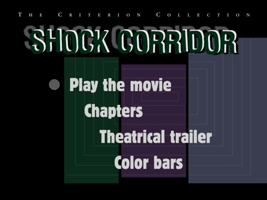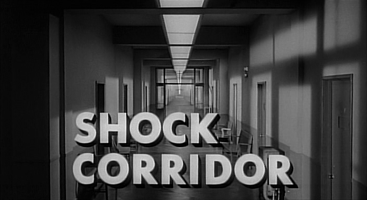written and directed by Samuel Fuller


Criterion #19.
Fine, Criterion Collection, you win. This one made me grin.
This movie popped out of the same can of mixed nuts as The Naked Kiss, but it had a little more punch to it. It wanders even farther into deep left field, and though it may not have been “kind of amazing,” it was certainly a wide-eyed head-shaker. And I can go for one of those every now and then.
I try not to do plot summaries but in this case I think it will double as an aesthetic summary.
In order to solve a murder at a mental hospital, an overambitious reporter goes undercover: he pretends to be insane and intentionally gets himself committed. His ultimate goal is to win the Pulitzer Prize, which is mentioned frequently as the inevitable outcome of this adventure. He first spends a year being coached on how to impersonate a madman, and then puts the plan into action by having his girlfriend — a stripper — pretend that she’s his sister and turn in her “brother” for threatening her with his violent, incestuous impulses. The girlfriend does this but only under pressure; she hates the whole scheme and fears for the reporter, as well she should. Once inside, he turns his attention to the only three witnesses to the murder, each of whom is a delusional schizophrenic. Each has been driven mad by being the victim of a contemporary American problem — communism, racism, and the nuclear arms race, respectively — and is now in a bizarre state of denial that inverts the problem (for example: a young black man who couldn’t handle the pressure and abuse of attending a newly desegregated school now believes he is the founder of the Ku Klux Klan). But each of the three is eventually coaxed into delivering a looking-into-the-distance soliloquy that reveals his underlying true story, after which our hero spits out the unrelated question “who killed Sloan in the kitchen?” and gets some fragment of information just before the witness lapses back into his insanity. After a series of tribulations — which include receiving electric shock treatment (= montage treatment) and being brutally attacked by the inhabitants of the “nympho” ward — the reporter solves the crime, battles the killer in a prolonged pots-and-pans-everywhere brawl, and finally maybe wins the Pulitzer Prize… BUT AT WHAT COST? For, you see, in the process, he himself has gone mad. Ironic enough for ya?
It’s not? Really? Tough crowd.
The cockamamie concept and undisguisedly clonky three-bears structure wouldn’t be out of place in a comic book, or a radio play of 15 years earlier. Almost every element here feels like it was plucked from the mainstream of kitschy sensationalist hackwork. So once again, the absurd effect — and this one really does feel absurd — is mostly due to the heightened expectations that a feature film brings.
But notice I said almost every element. When Constance Towers (yes, it’s her again) begins her striptease by singing a sexy tune through the feathers of a boa that completely encircles and obscures her head, looking like something from Mummenschanz, there is no getting around the fact that this movie and this director have, of their own volition, strayed from the road well-traveled. And a few touches like that go a long way; once you’ve seen a thing like that, it becomes harder to remember whether, say, a coven of haggard nymphomaniacs murmuring “he’s mine! he’s mine!” is a cliché, or whether it’s a brand new experience. The impression that this movie was a brand new experience hung in the air longer than it did with The Naked Kiss, and that was good enough for me. If the movie you are watching on TV with no expectations turns out to be Shock Corridor, you are in luck! (I offer this sentence as a clean press quote for the marketing people to put on the poster if they so choose.)
Once again, Fuller incorporates what seem to be his own 16mm tourist movies, inserting them whenever a character remembers having been to a foreign country. Economical and self-involved. The hero’s climactic fight with insanity is portrayed with the full force of Fuller’s art: first the reporter is seen flopping around in the hospital corridor set, as it fills symbolically with the rain in his mind. He shrieks and bangs helplessly on the doors; then he is zapped by animated lightning like Luke Skywalker and falls into a crazed Vertigo-style montage…. revolving principally around color home movies of Niagara falls.
That’s right, I forgot to mention: the home movies are in color, in the middle of a black-and-white film. To no particular effect. Apparently these had been separated from the rest of Shock Corridor until Criterion came along, so good for them. One character introduces his flashback by saying that he can see it now, “in color,” and another says that he dreams about it every night, “in color.” As usual, the choice itself might be weird and arty (and/or folk-arty), but the handling is pulp 101: everything must be stated and complete with exclamation points. These movies feel like the work of a very proud man.
So I’m supposed to talk about the themes? Like, “is modern America, what with all its problems and such, kind of like an insane asylum?” or “who’s to say who’s really sane?” No, sorry, not going to do that. I have my dignity.
People who make claims for the deep artistic quality of this movie because of the serious intent and serious issues at its heart: what’s wrong with you??? If I put on a 5-foot stovepipe hat with a sign on it, it doesn’t matter whether the sign says “the soul of the American nation is tormented by its own hypocrisies” or “eat at Joe’s”: no matter what it says, it’s still ridiculous. This movie is wearing a 5-foot stovepipe hat. I am not going to discuss the damn sign. Not in this company!
I will discuss this instead: just before administering shock therapy, a doctor grimly pronounces “puberty” as “pooberty,” which of course prompted me to look up the legitimacy of that pronunciation. OED and Merriam-Webster both say no way, never. But I did find plenty of people reminiscing about their embarrassing high school teachers — and Johnny Carson — pronouncing it that way. Sounds like it was a moderately widespread mistake in middle America 50 years ago. Considering the time and place, I imagine it was the sort of word for which many people had to guess the pronunciation, and then go for years with no opportunity to have an error be heard or corrected… at least not by anyone with more authoritative knowledge. And for the uptight, “pooberty” probably does seem like a more dignified reading. The y-glide in “pyube” seems vulgar in some vague Nabokovian way, whereas the Latinate syllable “poob” has ancient Roman associations.
Peter Breck looks sort of like Alec Baldwin in deadpan mode, and somehow he has just the right manner and magnetism for this impossible material. As with Alec Baldwin there’s the sense of a well-suppressed smirk, which, under the circumstances, is highly sympathetic. And he’s willing to shriek like a melting witch in nearly every scene, which is a plus. (Also he has a slight Han Solo quality, yes?)
I also want to single out the opera singer lunatic as having been engagingly naturalistic. I think my favorite moment in the movie was the color scene where he feeds our hero a lot of chewing gum in bed, telling him that chewing it will make his jaw tired and help him fall asleep. That guy’s performance is the closest in the movie to the style of One Flew Over the Cuckoo’s Nest, to which I was tempted to make comparisons for a while until it became clear that none were called for.
Once again it seems likely that for most people, the trailer will be just about the right amount of Shock Corridor. Though be warned that this is one of those trailers that shamelessly misrepresents the movie. Luckily you’ve got my handy summary to set you straight.
Your track 19: Main title. Another middle-of-the-road mushfest from Paul Dunlap.